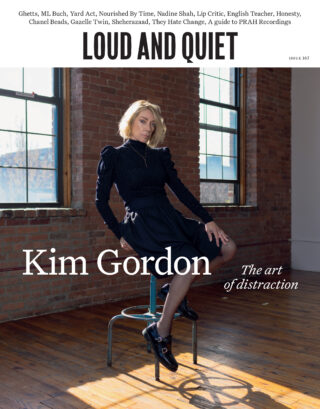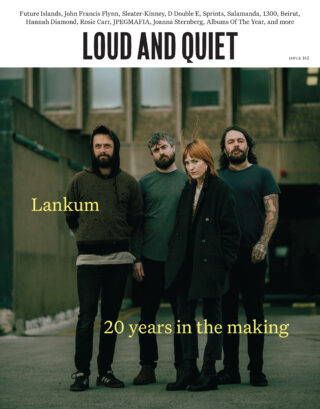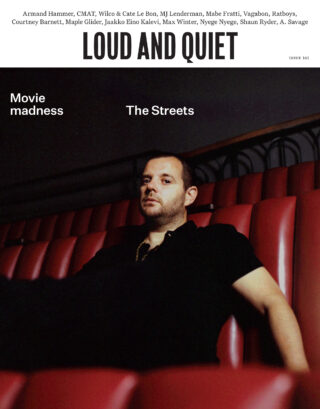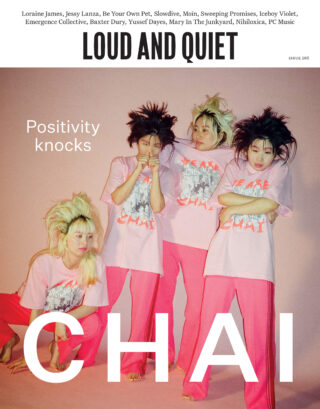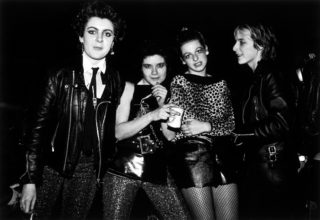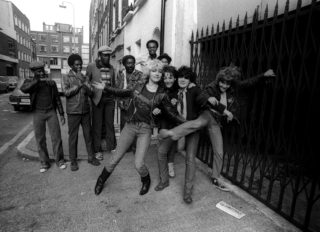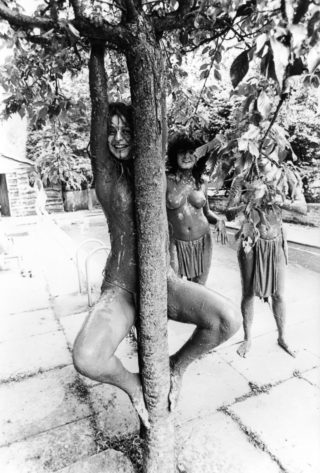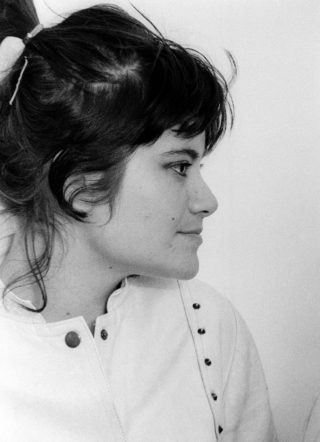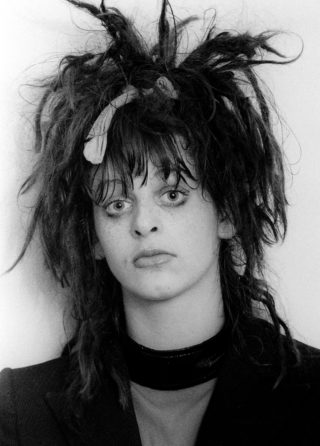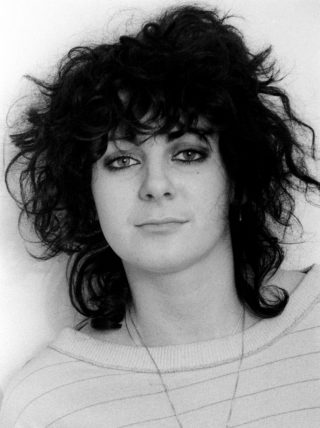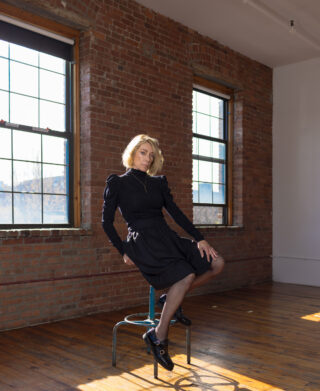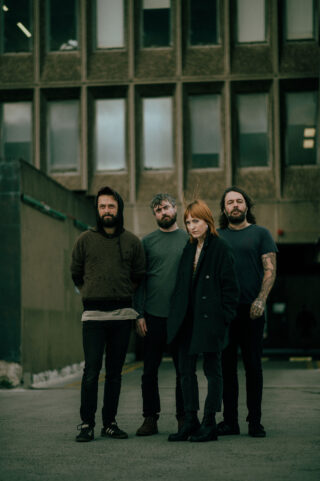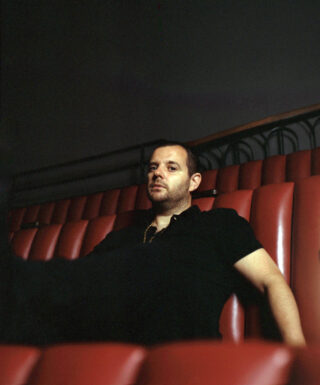But back in the bleak mid-’70s when The Slits embarked on the legendary White Riot Tour alongside The Clash, The Jam, Buzzcocks, and Subway Sect, Viv recalls the rest of the country weren’t quite prepared for the four girls:
“We were like the massive rebels of the tour. The way we looked was much more unusual or far out than the guys, because by now people were used to rock and roll looking guys, but girls in fetish wear, with their t-shirts slashed, hair standing a mile on end and in Doctor Martin boots? They couldn’t stand it and they would say we will only have them in the hotel if they walk from the door to the lift and we don’t want to see them again till the next day. Everyday the tour manager would threaten to throw us off the tour, Norman the bus driver had to be bribed daily to let us on the bus. It was bloody stressful.”
Tessa: “I can’t really think of anyone like us before. I think because we were women it was even more threatening because of the way we looked. Especially when we were going out of London it seemed to cause even more shock. I think we got thrown out of one hotel because I had The Slits graffiti-ed on the side of my case. I suppose you have to look at what it followed, the whole ’60s apathy thing and the fact that it was a movement, it wasn’t just one group. Something had to break at that period. It was probably the worst style ever in the ’70s as far as I can remember, it was vomit-making, the style was so horrible, the haircuts, the clothes, the house design, the avocado green bathroom suites.”
But it wasn’t just The Slits being female that made them different, it was the style of their music too. When all the other punk bands were shouting “1234”, The Slits were playing to a different beat. They were amongst the first bands on that scene to draw their inspiration from reggae music and at the time of the White Riot tour they were being managed by Roxy DJ Don Letts. For Tessa, reggae was hugely inspiring to the way she played. “There were more reggae artists playing live, like Big Youth and Burning Spear, and the film The Harder They Come, which was really influential, and there were a lot of sound systems and shebeen blues clubs. It was just a real time for reggae in the ’70s. Before punks had ever made any records there was reggae. Thank God, because it was hugely inspiring. Don Letts was djing at the Roxy club playing pure reggae so we got to know all these songs and even to this day I love Jamaican music, just love it.”
I ask her how the Jamaican community took to four punk girls turning up to their clubs. “Maybe it was more acceptable to be a white woman than to be a white man and be there. In the Ballyhigh Club in Streatham, Ari would just start dancing and be surrounded by a crowd of people. But somewhere like the Four Aces in Dalston, which doesn’t exist anymore, it, would be much more of a tense atmosphere, like who do these people think they are, coming into our club. Ari used to go on her own from a really young age, she had quite a nerve, she was 15, but you can’t help but like her.”
The Slits were also the first musicians to point out that women played their instruments in a different way to men, quite a revelation but for Tessa it was the only way she knew. “I like the fact that women do play differently,” she says. “For me I was always playing with other women so I didn’t know any different.”
Viv, though, was making it up as she went along. “We, in a way, tried to fit in with boys and how they played,” she says. “I hadn’t been taught an instrument so I was literally making it up as I went along and with things Keith Levene [later of PiL] was showing me, though he wasn’t showing me straight forward things. He was teaching me more the mentality than the actual chords. He gave me the confidence to do what I wanted and I would make things up and he would say, ‘What time is that in? It works but it shouldn’t.’” At the time Viv was going out with Mick Jones. “Mick didn’t teach me anything. Only the guys you don’t sleep with teach you something.”
Unlike the other punk bands, The Slits didn’t sign to a label straight away in 1977. Viv didn’t think the band were ready. “Mainly we didn’t sign because we knew we didn’t sound like we did in our heads. That and the record companies wanted to market us and package us up as sexy punk girls. There really weren’t any other all girl bands at the time. We had to wait till someone took us for who we where “
Finally, the band signed to Island in 1978. What was particularly unusual is that Island Records agreed to give them full creative control on everything, from the artwork to the choice of single, something that is still rare in the business today. The band’s first single, ‘Typical Girls’, was backed with a cover version of Marvin Gaye’s ‘I Heard It Through The Grapevine’. It was a song that Chris Blackwell, founder of Island Records, thought would give the girls more success, but they were adamant they would go with their own song ‘Typical Girls’ as the A-side. Although the band were able to make their own career decisions, they weren’t always the most financially-viable. I ask Viv if the term ‘bloody-minded’ would be a suitable term to describe The Slits’ attitude to the music business at the time.
“I think every decision we made, made it difficult for us. We kept thinking ‘Why aren’t we commercial? Why aren’t we on TV?’ On the other hand, we were so uncompromising on how we spoke to people, how we did interviews, how we looked, everything was utterly uncompromised. So we led ourselves down this difficult cult route. Which actually, 20 years later, worked out pretty well as it kept The Slits pure and now because we were so uncompromising the band has such a strong identity. But it did mean we made no money and we had no commercial success.”
Their success seems on a par to a band like The Velvet Underground’s in the ’60s. Neither bands sold huge amounts of records on release but their influence has been huge and ongoing. But when I ask Tessa about when she first became aware of their now legendary status, she seems blissfully unaware of quite how influential the band have been.
“I wasn’t aware at all till I hooked up with Ari a few years ago. She kept going on about how we had influenced the whole Riot Grrrl movement. I didn’t get it until we started playing in America and we had an audience out there, a young audience. I was quite shocked.”
But long before Riot Grrrl, a young Madonna had been in the audience and you can see the influence The Slits had on her style on her first appearances on Channel 4’s innovative music programme The Tube. But again, Tessa has a very grounded view to this. “I think she must have been quite influenced by the way Viv dressed as she came to see us before her career took off but I don’t like to go on about things like that. I just think, so what? Everyone is going to get influenced by what they see. I just don’t like to blow my own trumpet. I just want to keep moving forward and try and not get egotistical about anything.”
